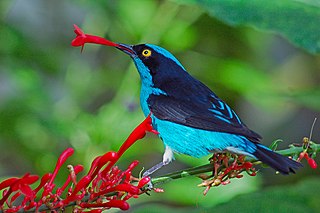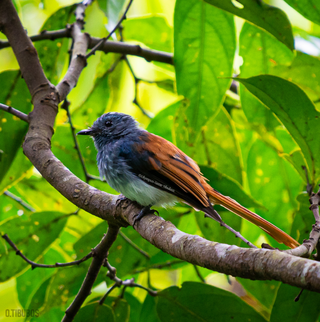
The blue dacnis or turquoise honeycreeper is a small passerine bird. This member of the tanager family is found from Nicaragua to Panama, on Trinidad, and in South America south to Bolivia and northern Argentina. It is widespread and often common, especially in parts of its South American range.

The tit-like dacnis is a small neotropical passerine bird found in southern Ecuador and Peru. In Spanish, it is known as Azulito Altoandino. It is found in Andean montane scrub forests from 3000 m to 4600 m elevation.

The scarlet-thighed dacnis is a tanager 4¾" long. It is found in Costa Rica, Colombia, Ecuador and Panama.

The brown-hooded kingfisher is a species of bird in the subfamily Halcyoninae, the tree kingfishers. It has a brown head and blackish and turquoise wings. It is found in Sub-Saharan Africa, living in woodland, scrubland, forest edges, and also suburban areas. The International Union for Conservation of Nature (IUCN) has assessed it as being of least concern.

The scarlet-breasted dacnis is a species of bird in the family Thraupidae. It is found in Colombia and Ecuador. Its natural habitat is subtropical or tropical moist lowland forests. It is threatened by habitat loss.

The yellow-bellied dacnis is a species of bird in the family Thraupidae, the Tanagers. It is found in Amazonian regions of Colombia, Ecuador, Peru, Bolivia and Brazil; also the eastern Orinoco River region of Venezuela. Its natural habitat is the canopy of tropical humid lowland forest.

The turquoise dacnis is a species of bird in the family Thraupidae. It is endemic to Colombia. It is a rather distinct species of dacnis, formerly separated in the monotypic genus Pseudodacnis.

The black-faced dacnis is a species of bird in the family Thraupidae. It is commonly found typically in pairs throughout the Amazon Rainforest.

The black-legged dacnis is a species of bird in the family Thraupidae. It is endemic to Brazil.

The viridian dacnis is a species of bird in the family Thraupidae. It is found in Colombia and Panama.
The white-bellied crested flycatcher is a bird species in the family Stenostiridae; it was formerly placed with the drongos in the Dicruridae.

The spectacled monarch is a species of bird in the family Monarchidae. It is found in Australia, Indonesia, and Papua New Guinea. Its natural habitats are subtropical or tropical moist lowland forests, subtropical or tropical mangrove forests, and subtropical or tropical moist montane forests.

The Samoan flycatcher is a species of bird in the family Monarchidae. It is endemic to Samoa. Its natural habitats are subtropical or tropical moist lowland forests, subtropical or tropical moist montane forests, and rural gardens and is threatened by habitat loss.

The white-bellied pygmy tyrant is a species of bird in the family Tyrannidae. It is found in Bolivia and Peru. Its natural habitat is subtropical or tropical moist lowland forests.

The green-backed whistler or olive-backed whistler, is a species of bird in the family Pachycephalidae. It is endemic to the Philippines.

The white-bellied tit is a species of bird in the family Paridae. It is found in Cameroon, Kenya, Nigeria, South Sudan, Tanzania, and Uganda. Its natural habitats are subtropical or tropical dry forests and subtropical or tropical moist montane forests.

The Andaman shama is a species of bird in the family Muscicapidae. It is endemic to the Andaman Islands. It was previously considered a subspecies of the white-rumped shama. Its natural habitats are subtropical or tropical dry forests and subtropical or tropical moist lowland forests.

The white-bellied blue robin or white-bellied sholakili, is a bird of the family Muscicapidae. It is endemic to the Shola forests of the higher hills of southern India. The Nilgiri blue robin and this species were once considered separate species, later lumped as sub-species of a single species (major) and elevated again to full species in 2005 by Pamela C. Rasmussen. The species was earlier thought to be related to the shortwings and placed in the genus Brachypteryx and later moved to Myiomela since species in the genus Brachypteryx shows marked sexual dimorphism. In 2017, a study found that this is a sister group of the flycatchers in the genera Niltava, Cyornis and Eumyias among others. It was then placed in newly erected genus Sholicola. This small bird is found on the forest floor and undergrowth of dense forest patches sheltered in the valleys of montane grassland, a restricted and threatened habitat.

The Visayan fantail is a fantail endemic to the Philippines on islands of Negros, Panay, Guimaras, Masbate and Ticao. Until recently, it was considered conspecific with the blue-headed fantail and Tablas fantail.

The yellow-tufted dacnis is a species of bird in the family Thraupidae. It is commonly found typically in pairs throughout western Colombia and Ecuador and the Magdalena and Cauca valleys.





















